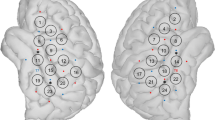Summary
The magnetic equivalents of SN10, Po, Na, Pa, Nb and Pb (SN10m, Pom, Nam, Pam, Nbm and Pbm) in short and middle latency auditory evoked potentials were measured with a 7-channel DC superconducting quantum interference device (SQUID). The sources of Pom, Nam, Pam, Nbm and Pbm responses were estimated to be located in the auditory cortex, while the source of SN10m was considered to be in a deeper part of the brain. In addition, the source of Pam was estimated to be in the vicinity of the moving N100m source. The source of Pbm was considered to be in a separate area, anterior to the source of Pam and N100m, which suggested that the source of Pam was located in the primary auditory cortex, while the source of Pbm was located in the secondary auditory cortex. The source of N100m was considered to spread from the primary auditory cortex to the secondary auditory cortex.
Similar content being viewed by others
References
Cacace, A.T., Satya-Murti, S. and Wolpaw, J.R. Human middlelatency auditory evoked potentials: Vertex and temporal components. Electroenceph. clin. Neurophysiol., 1990, 77: 6–18.
Celesia, G.G. Organization of auditory cortical area in man. Brain, 1976, 99: 403–414.
Davis, H. and Hirsh, S.K. A slow brain stem response for low-frequency audiometry. Audiology, 1979, 18: 445–461.
Deiber, M.P., Ibañez, V., Fischer, C., Perrin, F. and Maugiuére, F. Sequential mapping favors the hypothesis of distinct generators for Na and Pa middle latency auditory evoked potentials. Electroenceph. clin. Neurophysiol., 1988, 71: 187–197.
Erwin, R. and Buchwald, J.S. Midlatency auditory evoked responses: Differential effects of sleep in the human. Electroenceph. clin. Neurophysiol., 1986, 65: 383–392.
Hari, R., Aittoniemi, K., Järvinen, M.-L., Katila, T. and Varpula, T. Auditory evoked transient and sustained magnetic fields of the human brain. Exp. Brain Res., 1980, 40: 237–240.
Hashimoto, I. Auditory evoked potentials from the human midbrain. Electroenceph. clin. Neurophysiol., 1982, 53: 652–657.
Kuriki, S. and Takeuchi, F. Neuromagnetic responses elicited by auditory stimuli in dichotic listening. Electroenceph. clin. Neurophysiol., 1991, 80: 406–411.
Lee, Y.S., Lueders, H, Dinner, D.S., Lesser, R.P., Hahn, J., Klem, G. Recording of auditory evoked potentials in man using chronic subdural electrodes. Brain, 1984, 107: 115–131.
Pantev, C., Hoke, M., Lehnertz, K., Lütkenhöner, B., Anogianakis, G. and Wittkowski, W. Tonotopic organization of the human auditory cortex revealed by transient auditory evoked magnetic fields. Electroenceph. clin. Neurophysiol., 1988, 69: 160–170.
Pantev, C., Hoke, M., Lehnertz, K. and Lütkenhöner, B. Neuromagnetic evidence of an amplotopic organization of the human auditory cortex. Electroenceph. clin. Neurophysiol., 1989, 72: 225–231.
Pelizzone, M, Hari, R., Mäkelä, J.P., Huttunen, J., Ahlfors, S., Hämäläinen, M. Cortical origin of middle-latency evoked responses in man. Neuroscience Letters, 1987, 82: 303–307.
Picton, T.W., Hillyard, S.A., Krausz, H.I. and Galambos, R. Human auditory evoked potentials. I. Evaluation of components. Electroenceph. clin. Neurophysiol., 1974, 36: 179–190.
Rogers, R.L., Papanicolaou, A.C., Baumann, S.B., Saydjari, C., Eisenberg, H.M. Neuromagnetic evidence of a dynamic excitation pattern generating the N100 auditory response. Electroenceph. clin. Neurophysiol., 1990, 77: 237–240.
Scherg, M. and von Cramon, D. Evoked dipole source potential of the human auditory cortex. Electroenceph. clin. Neurophysiol., 1986, 65: 344–360.
Scherg, M., Hari, R. and Hämäläinen, M. Frequency-specific sources of the auditory N19-P30-P50 response detected by a multiple source analysis of evoked magnetic fields and potentials. In: S.J. Williamson, M. Hoke, G. Stroink and M. Kotani (Eds.), Advances in Biomagnetism. Plenum Press, New York, 1989: 97–100.
Woods, D.L., Clayworth, C.C., Knight, R.T., Simpson, G.V. and Naeser, M. A. Generators of middle-and long-latency auditory evoked potentials: Implications from studies of patients with bitemporal lesions. Electroenceph. clin. Neurophysiol., 1987, 68: 132–148.
Yamamoto, T., Williamson, S.J., Kaufman, L., Nicholson, C. and Linas, R. Magnetic localization of neuronal activity in the human brain. Proc. Natl. Acad. Sci. (USA), 1988, 85: 8732–8736.
Author information
Authors and Affiliations
Rights and permissions
About this article
Cite this article
Yoshiura, T., Ueno, S., Iramina, K. et al. Human middle latency auditory evoked magnetic fields. Brain Topogr 8, 291–296 (1996). https://doi.org/10.1007/BF01184787
Accepted:
Issue Date:
DOI: https://doi.org/10.1007/BF01184787




